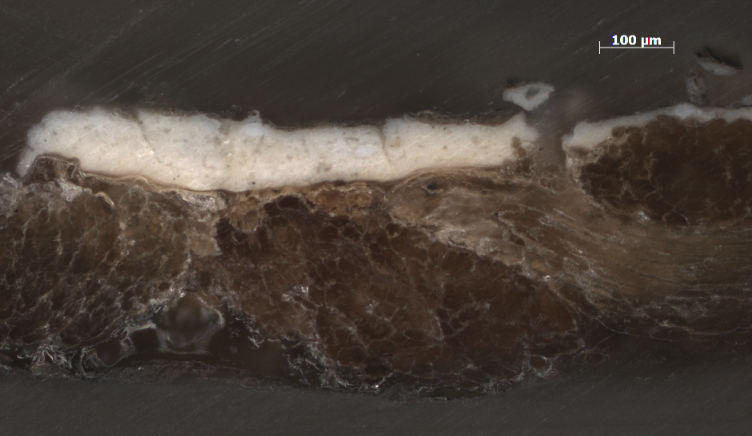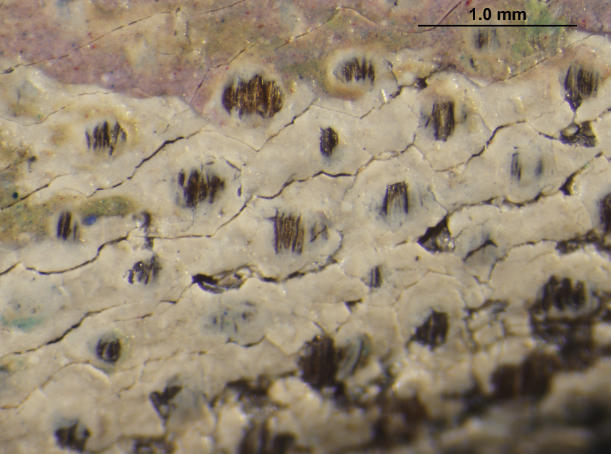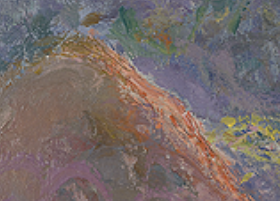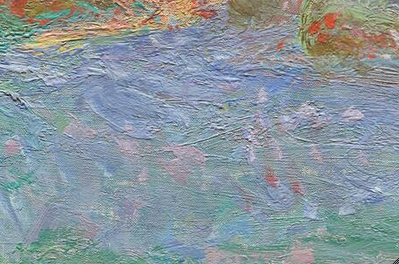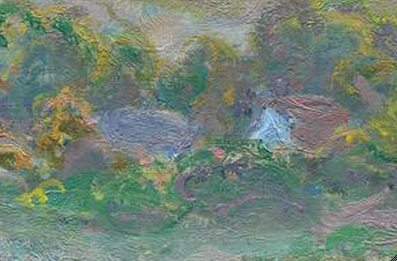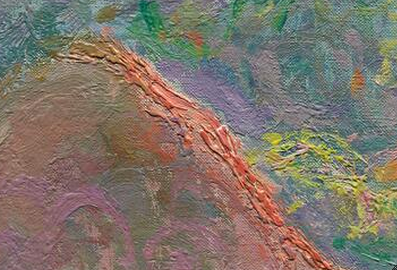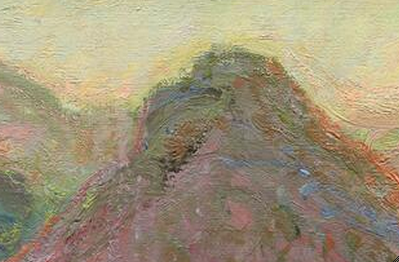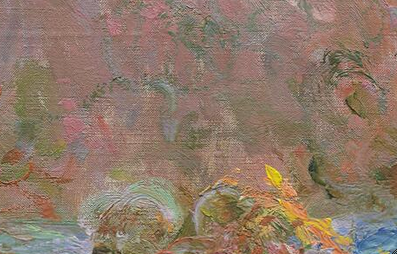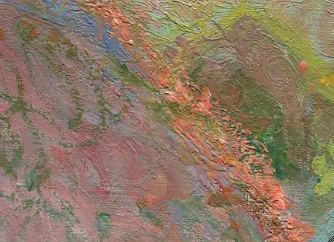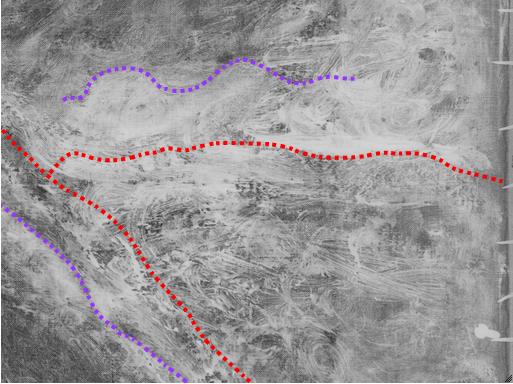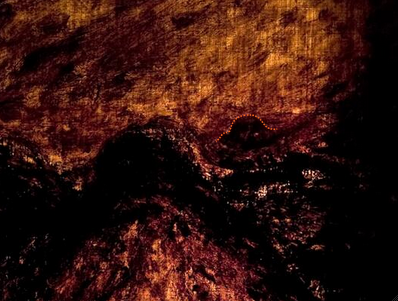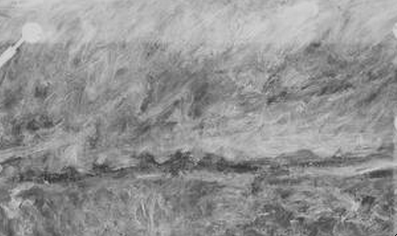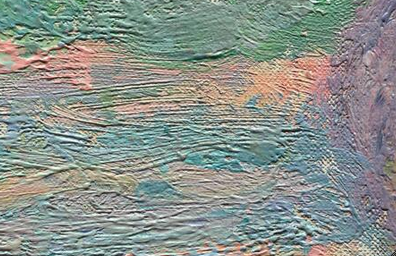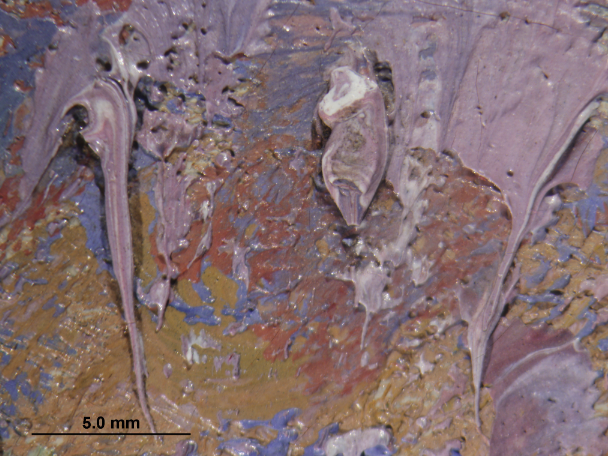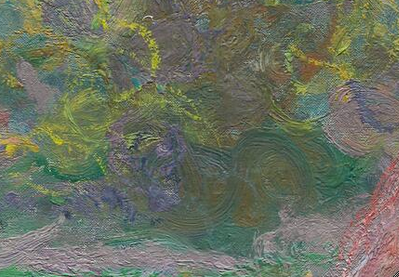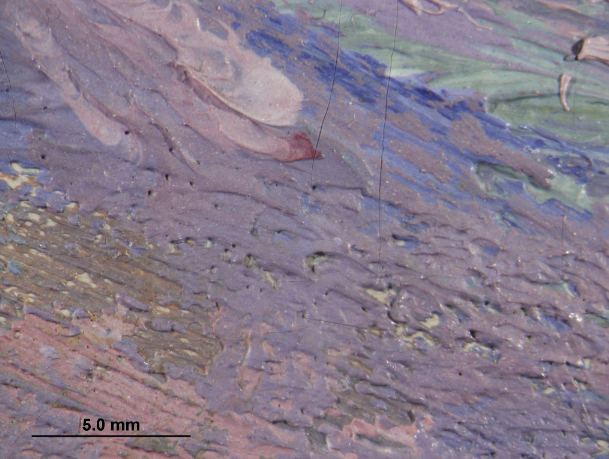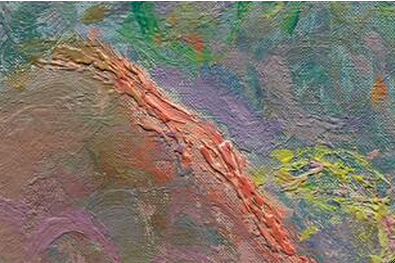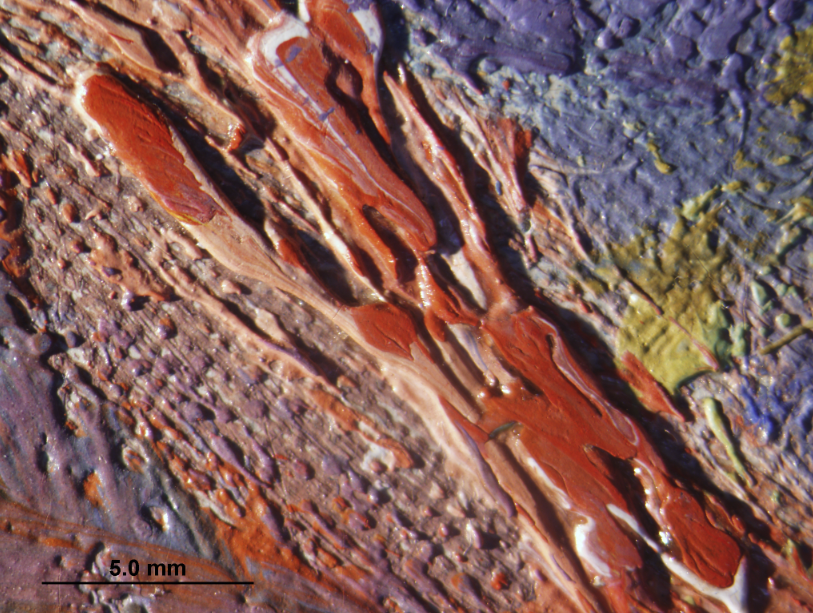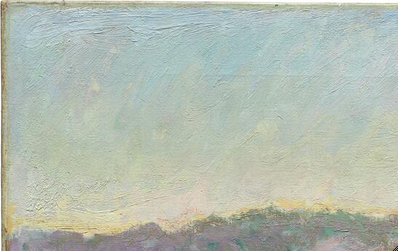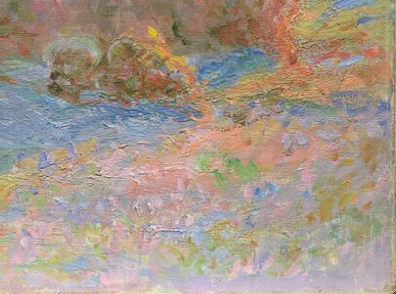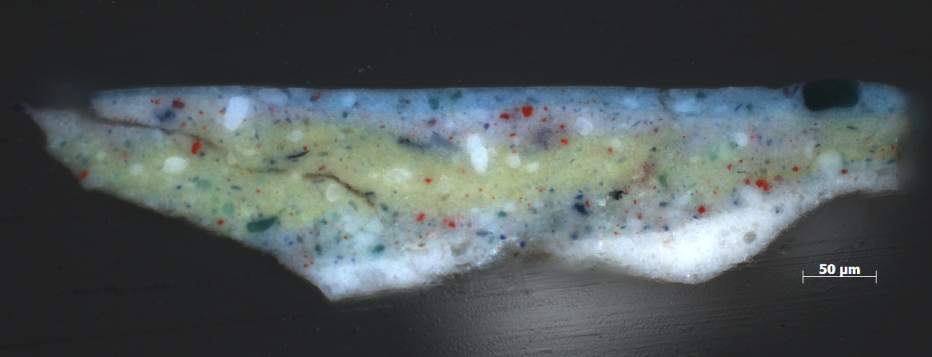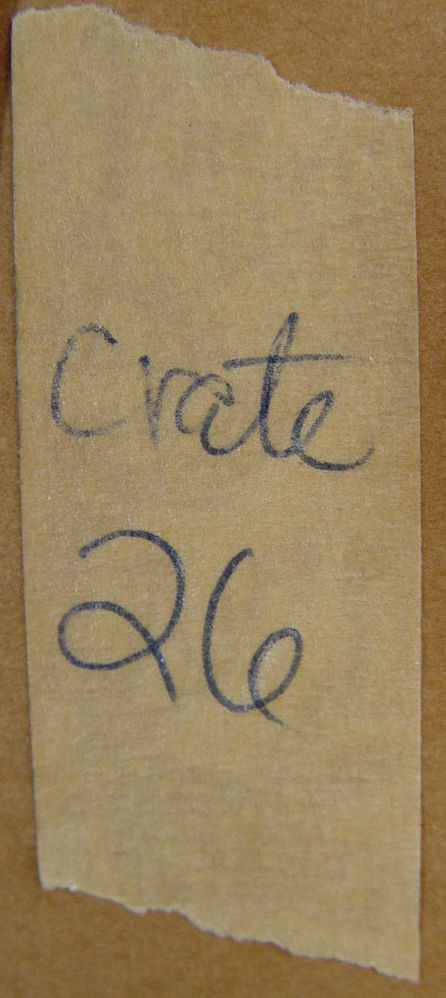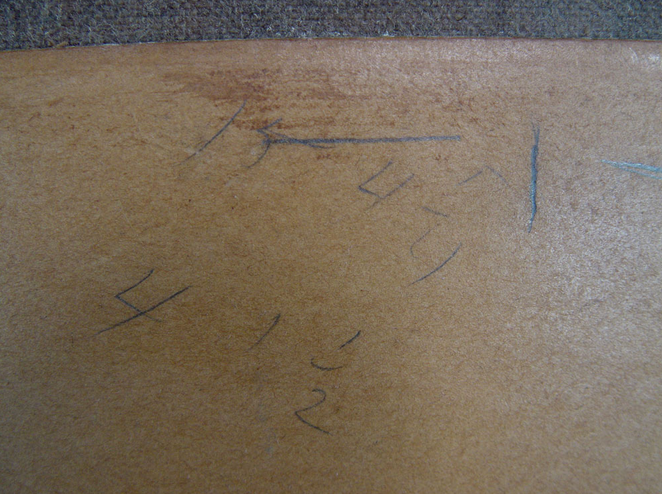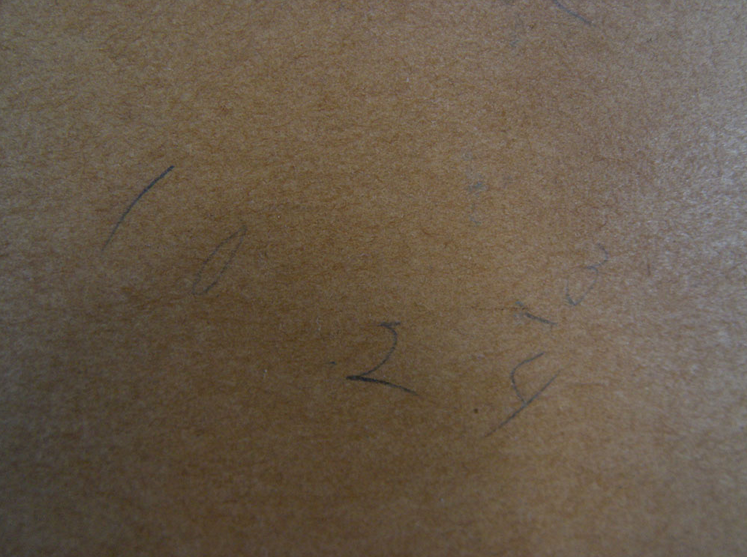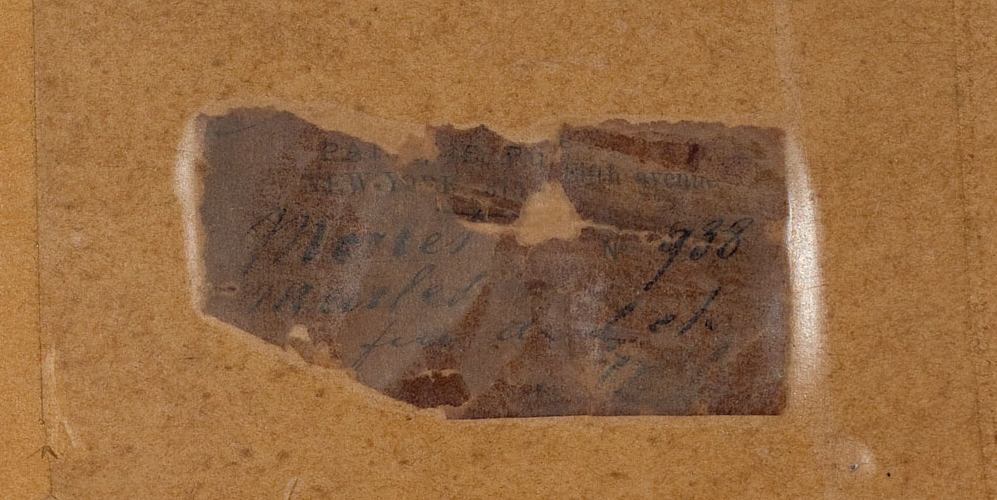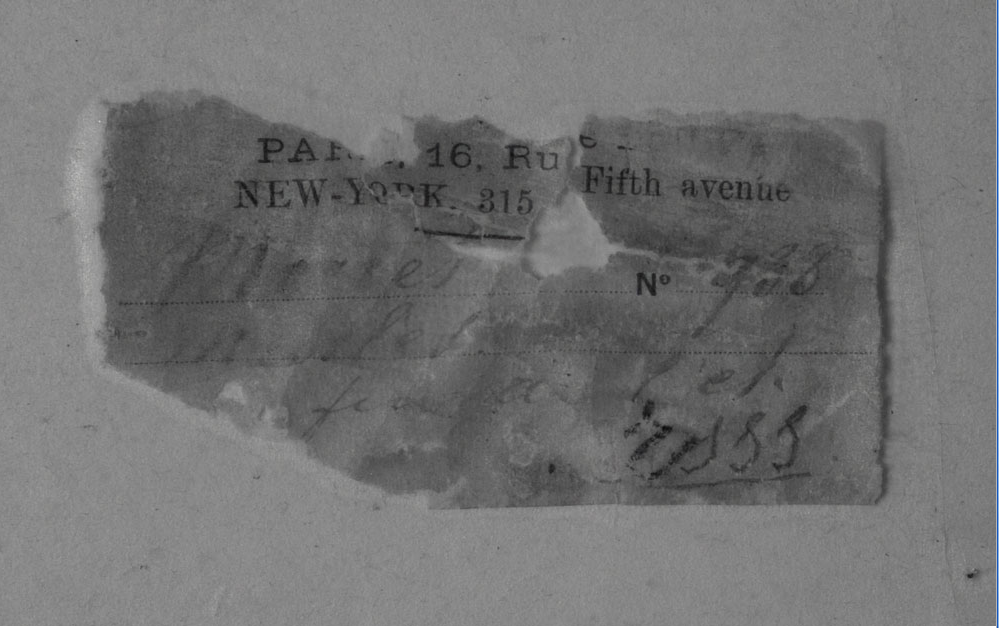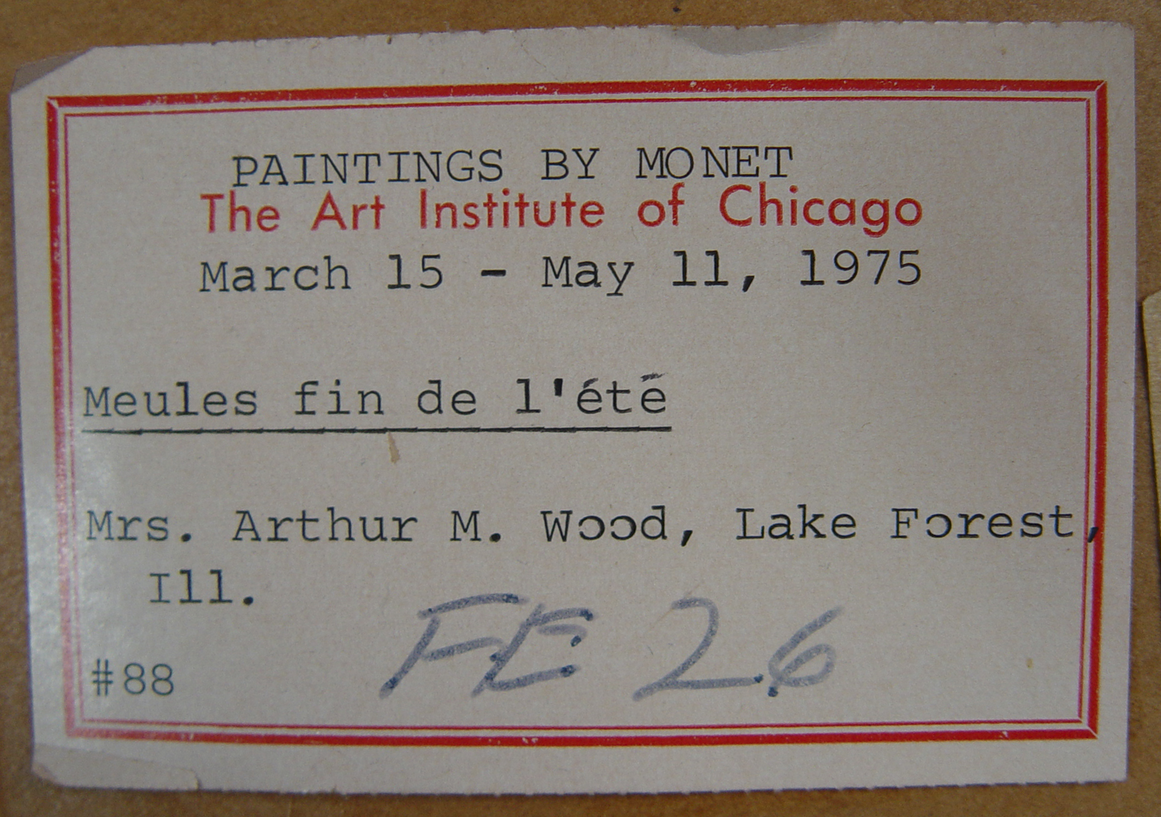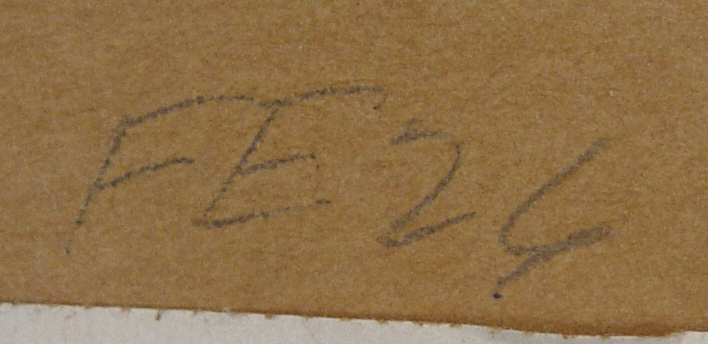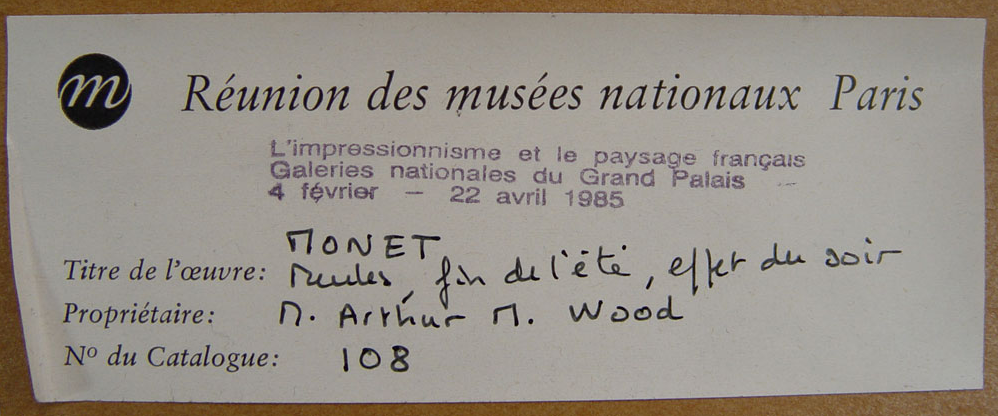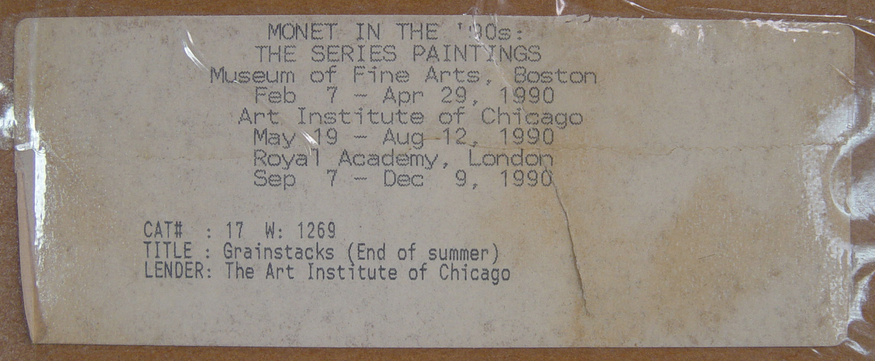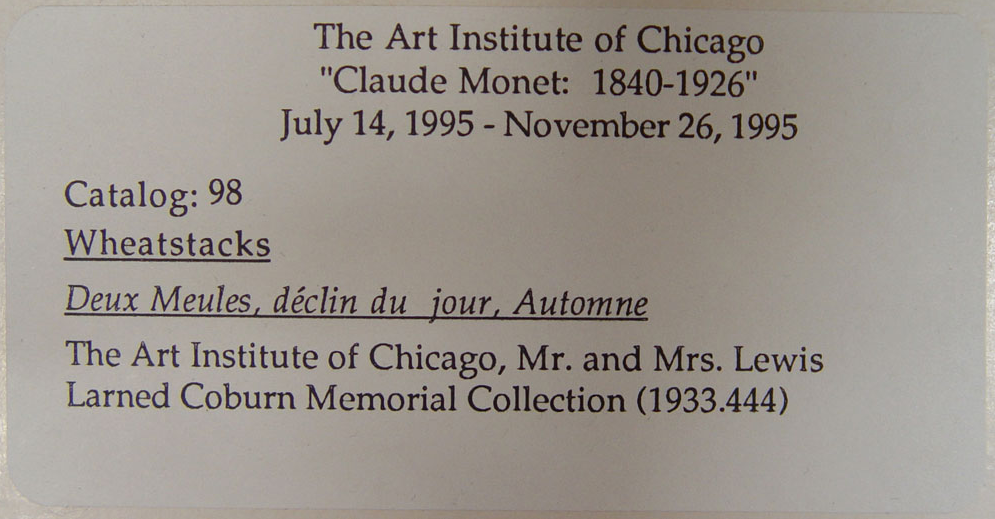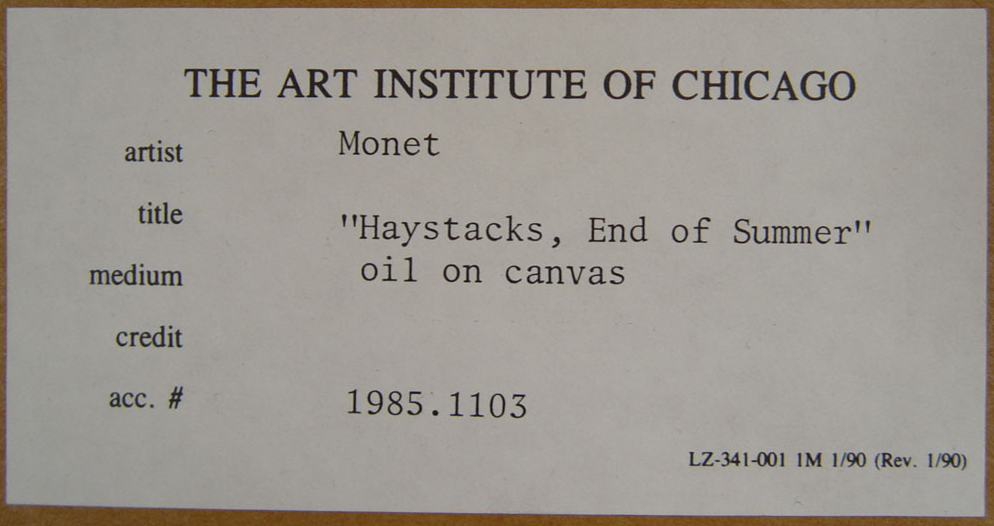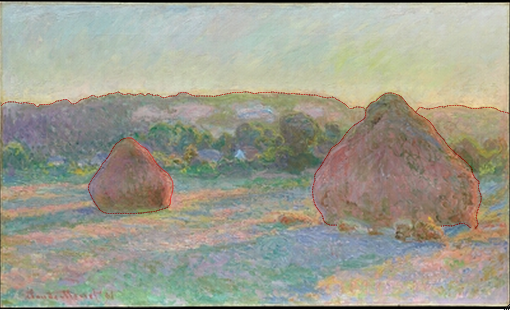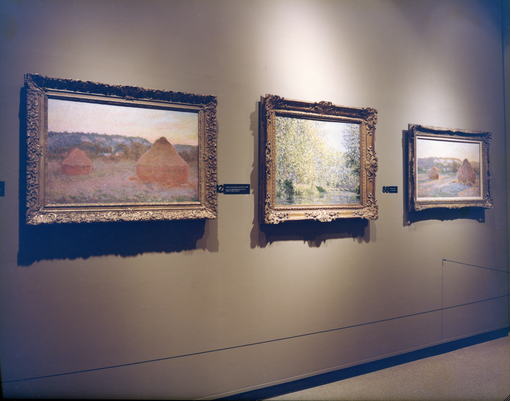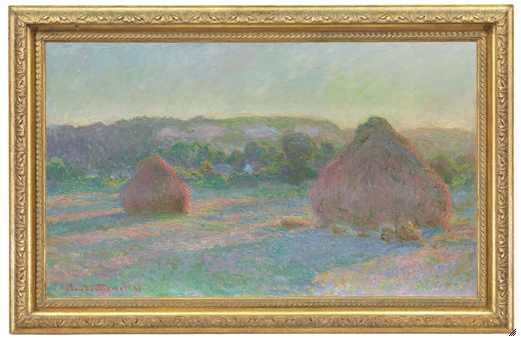Cat. 27
Stacks of Wheat (End of Summer)
1890/91
Oil on canvas; 60 × 100.5 cm (23 5/8 × 39 9/16 in.)
Signed and dated: Claude Monet 91 (lower left, in orange-red paint)
The Art Institute of Chicago, gift of Arthur M. Wood, Sr., in memory of Pauline Palmer Wood, 1985.1103
Technical Report
Technical Summary
Claude Monet’s Stacks of Wheat (End of Summer) was painted on a non-standard-size, [glossary:pre-primed] linen [glossary:canvas]. The [glossary:ground] consists of a single, off-white layer. A [glossary:warp-thread match] was detected with seven other Monet paintings from the Art Institute's collection: The Petite Creuse River (cat. 25 [W1231], inv. 1922.432); Stacks of Wheat (End of Day, Autumn) (cat. 28 [W1270], inv. 1933.444); Stacks of Wheat (Sunset, Snow Effect) (cat. 29 [W1278], inv. 1922.431); Stack of Wheat (Thaw, Sunset) (cat. 32 [W1284], inv. 1983.166), Sandvika, Norway (cat. 34 [W1397], inv. 1961.790); Branch of the Seine near Giverny (Mist) (cat. 36 [W1475], inv. 1933.1156); and Water Lily Pond (cat. 37 [W1628], inv. 1933.441), suggesting that the fabric for these paintings came from the same bolt of material. The painting has a rich and varied surface texture. This includes areas of open brushwork where thick strokes of [glossary:impasto] are juxtaposed with very thinly painted passages that leave the ground and canvas texture visible. Other areas consist of more fluid paint applications that appear to have been modified by the artist through the addition of extra medium to the tube paint. Final touches to the painting include brushstrokes lightly dragged across the surface, which emphasize the texture of the layers below. This includes the yellow and orange strokes used to indicate the foliage in the distant trees. For the most part, the composition was built up with little deviation from the initial [glossary:lay-in]. It appears that only the large stack at right was slightly modified during the painting process by extending the top and sides over the landscape. Some adjustments may also have been made to the horizon on the right side of the painting.
Multilayer Interactive Image Viewer
The multilayer interactive image viewer is designed to facilitate the viewer’s exploration and comparison of the technical images (fig. 27.1).
Signature
Signed and dated: Claude Monet 91 (lower left, in orange-red paint) (fig. 27.2). The signature was applied when the underlying paint layers were already dry. The paint from some of the taller letters (Cl, d, and M) has been smudged to the left (fig. 27.3).
Structure and Technique
Support
Canvas
Flax (commonly known as linen).
Standard format
The dimensions do not correspond to a standard-size [glossary:stretcher]; the stretcher was probably custom-ordered.
Weave
[glossary:Plain weave]. Average [glossary:thread count] (standard deviation): 23.4V (0.6) × 22.6H (0.7) threads/cm; the vertical threads were determined to correspond to the warp and the horizontal threads to the weft. A warp-thread match was determined with seven other Monet paintings in the Art Institute's collection: The Petite Creuse River (cat. 25 [W1231], inv. 1922.432); Stacks of Wheat (End of Day, Autumn) (cat. 28 [W1270], inv. 1933.444); Stacks of Wheat (Sunset, Snow Effect) (cat. 29 [W1278], inv. 1922.431); Stack of Wheat (Thaw, Sunset); (cat. 32 [W1284], inv. 1983.166); Sandvika, Norway (cat. 34 [W1397], inv. 1961.790); Branch of the Seine near Giverny (Mist) (cat. 36 [W1475], inv. 1933.1156); and Water Lily Pond (cat. 37 [W1628], inv. 1933.441).
Canvas characteristics
There is pronounced [glossary:cusping] along the right edge, moderate cusping on the left edge, and mild cusping along the top and bottom edges.
Stretching
Current stretching: Dates to the lining applied prior to acquisition of the painting in 1985 (see Conservation History); copper tacks spaced approximately 2–3 cm apart. Another series of empty holes, which correspond to holes in the current stretcher, appears to be more recent.
Original stretching: Tack holes spaced 5–8 cm apart; these holes appear to correspond to the cusping pattern in the canvas on the left, top, and bottom [glossary:tacking edges], but not on the right tacking edge where the cusping is wider and more irregular. There are a few additional holes, located on or close to the top and bottom foldovers (there are approximately four holes on each edge, fairly regularly spaced along the length of each side). The origin and purpose of the holes are not known.
Stretcher/strainer
Current stretcher: Five-membered wooden expansion bolt stretcher. The top member is slightly bowed. Depth: 3.2 cm.
Original stretcher: Discarded, not documented. Depth: A second crease observed in places on the tacking margin (presumably where excess canvas was folded over the back edge of the original stretcher) suggests that the original stretcher depth was approximately 1.5–2 cm.
Manufacturer’s/supplier’s marks
None observed in current examination or documented in previous examinations.
Preparatory Layers
Sizing
Not determined (probably glue).
Ground application/texture
The ground layer extends to the edges of all [glossary:tacking margins], indicating that the canvas was cut from a larger piece of primed fabric, which was probably commercially prepared. The ground consists of a single layer that ranges from approximately 10 to 100 µm in thickness, with the layer thicker in the interstices of the canvas and much thinner on the tops of the canvas threads. (fig. 27.4)
Color
Off-white. Some dark pigment particles were observed under magnification (fig. 27.5).
Materials/composition
Analysis indicates the presence of the following components: lead white and calcium carbonate (chalk), with traces of bone black, iron oxide, alumina, silica, and various silicates. Binder: [glossary:Oil] (estimated).
Compositional Planning/Underdrawing/Painted Sketch
Extent/character
No [glossary:underdrawing] was observed with [glossary:infrared reflectography] (IRR) or microscopic examination.
Paint Layer
Application/technique and artist’s revisions
The composition was laid in using strokes of thinly applied paint in more subdued colors than those used in the surface layers. For the small stack at left, the first application of thin reddish-brown paint, which barely covers the ground layer and leaves the canvas texture visible, can be seen occasionally through breaks in the upper brushwork (fig. 27.6). The hills in the background appear to have been laid in with shades that range from pale bluish-gray to greenish-gray. In the sky, warm off-white and gray tones were predominantly used for the initial painting. There is no overall [glossary:underpainting] in the field where the stacks are located; rather, this area consists of a buildup of individual strokes in a variety of pale hues (fig. 27.7). In localized areas, such as the long bluish-gray shadow extending from the base of the large stack, broader applications of thin, more uniform color were applied over the ground layer; in this case, a pale bluish-gray tone (fig. 27.8). In both the sky and the foreground, the earliest paint layers often consist of more textural brushstrokes with the ridges of the brush marks remaining visible through subsequent paint applications. The initial lay-in of the composition was left somewhat sketchy, with small areas of exposed ground visible throughout the canvas (fig. 27.9). The artist appears to have worked up the painting as a whole, moving back and forth between different areas of the composition.
The basic size and placement of the two stacks was laid out early in the painting process. At the upper right edge of the small stack, just below the thick orange outlining stroke that was applied later in the painting process, exposed ground is visible at the juncture between the stack and the surrounding landscape, indicating that the wheat stack and the distant landscape were built up simultaneously (fig. 27.10). In the large stack at right, on the other hand, a dense buildup of paint in a broad band around the sides and top suggests that the stack’s dimensions were increased as the painting was worked up, making the stack in the final painting significantly larger than its initial lay-in (fig. 27.11). The surface paint layers around the edges of the large stack consist of a more continuous buildup of [glossary:wet-in-wet] paint application (fig. 27.12), quite different from the more open network of superimposed brushstrokes used in the center of the stack and extensively throughout the composition (fig. 27.13). The continuous buildup of paint around the edges of the large stack makes it difficult to see the underlying layers; however, at the very edges, where there are breaks in some of the final brushwork, it is clear that the landscape continues underneath the edge of the stack to some extent (fig. 27.14).
Small areas of exposed ground visible intermittently along the upper limits of the distant hills suggest that the general horizon line was established early on (fig. 27.15). On the right side of the large stack, there is an area of densely built-up paint on and above the horizon line, which may indicate that some adjustments were made there (fig. 27.16). When viewed with transmitted light, a shape similar to the peak of the large stack is visible just to the right of the large stack, but it is unclear if this is related to an earlier form (fig. 27.17). Parts of the sky and the hillside, especially on the left side, were built up using undulating, zigzag strokes, which provide a distinct texture in those areas (fig. 27.18). These rhythmic brushstrokes were worked wet-in wet, with subsequent colors applied on top when the paint was dry, leaving the underlying texture undisturbed.
Overall, the painting has a rich, brushmarked surface, built up in an open network of strokes that leaves small areas of ground and earlier paint layers exposed (fig. 27.19, fig. 27.20). In some places, the underlying paint strokes are so heavily built up that the texture remains visible even when their color has been completely covered by subsequent paint (fig. 27.21). In other areas, strokes of low impasto lie adjacent to thinly painted passages (fig. 27.22) or were dragged directly over exposed ground where the canvas texture remains evident (fig. 27.23). It appears that the artist incorporated additional medium into some of his paints to achieve a more fluid consistency. This can be seen, for example, in the swirl of deep-green and brown paint in the distant foliage to the left of the large stack (fig. 27.24). Here, the unmixed colors swirl together and the brushmarks have largely settled out to a smoother surface. In this area, the artist contrasted the smooth, fluid paint application with more textural brushstrokes and thinly applied paint layers where the canvas texture shows through, creating a varied surface. The thin yellow strokes, which were lightly dragged over the surface, depositing mainly on the high points of the underlying paint texture, were among the final additions to the painting. In some passages, particularly those associated with the more fluid paint applications, tiny bubble holes were often observed (fig. 27.25). Some areas of impasto look slightly flattened. While this effect can be caused by the lining process, here it looks like it may have occurred early on when the paint was still soft (fig. 27.26, fig. 27.27). The upper left and lower right corners of the painting look like they were reinforced by the artist after the painting was finished. In the upper left corner, the pale-blue paint added at the edges appears more fluid (at the horizon, a drip is visible) and opaque, but it looks like it was applied wet-in-wet with the adjacent sky paint (fig. 27.28). Along the lower right edge and corner, there is a band of pinkish-purple paint that appears more solid when compared with the discrete strokes used in the adjacent field. Here, the added paint at the edge appears to have been applied when the underlying paint was dry (fig. 27.29).
Painting tools
Brushes including 1.0 and 1.5 cm width, flat ferrule (based on width and shape of brushstrokes). Smaller brushes or the narrow end of a brush were perhaps used for finer strokes. Several brush hairs are embedded in the paint surface.
Palette
Analysis indicates the presence of the following pigments: lead white, cadmium yellow, vermilion, red lake, emerald green, viridian, cobalt blue, and ultramarine blue. [glossary:UV fluorescence] of many of the red and pink paint strokes indicates the liberal use of red lake throughout the landscape. Paint layers were found to contain complex mixtures of pigments (fig. 27.30).
Binding media
Oil (estimated).
Surface Finish
Varnish layer/media
The painting was cleaned in 1996 and was left unvarnished (see Conservation History). The painting has a subtly variable surface (matte in some areas, low gloss in others) depending on the qualities of the paint.
Conservation History
The painting was already wax-resin lined when it entered the collection in 1985. The date of the lining is unknown. [glossary:Retouching] observed around the edges of the painting probably dates to this treatment campaign.
In 1996, the painting was cleaned and left unvarnished. The treatment notes indicate that there were two [glossary:varnish] layers present on the painting. The upper layer appeared to be a [glossary:synthetic varnish], probably applied when the painting was lined. The lower varnish layer appeared slightly yellowed and may have been a thin [glossary:natural-resin varnish].
Condition Summary
The painting is in good condition. The canvas is wax-resin lined and stretched taut on an expansion bolt stretcher with no planar deformations. Along all of the edges, there is cracking, abrasion, and small losses in the paint and ground layers, as well as some small tears in the canvas fibers at the foldovers. All of these areas are stable. There is a series of fine vertical scratches near the left edge of the painting and similar randomly oriented scratches in the upper left part of the sky that were made when the paint was still soft. Some areas of impasto, such as that along the right side of the small stack, appear slightly flattened. This may have occurred early on when the paint was still soft. There is an overall network of fine age cracks that is mostly visible only under magnification. Some light [glossary:stretcher-bar cracks] are visible in the sky. Localized microcracking observed in some yellow-green paint mixtures may be related to the degradation of specific pigments. There is some flattening of paint and embedded wood fibers in the rebate area, related to framing when the paint was still soft. There are also some gold residues from the frame along the bottom edge. Discreet retouching is present around the edges of the painting (especially top, left, and right). Several brush hairs are embedded in the paint surface.
Kimberley Muir
Frame
Current frame (installed in 1995): The frame is not original to the painting. It is a reproduction of a Louis XIII convex frame with carved acanthus leaf on a recut bed and a guilloche front molding (Paul Mitchell Ltd., London, 1995). The frame is water gilded over red bole on gesso. The outer ogee, scotia, hollow, and cove sight are burnished. The frame is toned with thin washes of oil paint and glue [glossary:size]. The carved jelutong wood moldings are mitered with dovetail splines. The molding, from perimeter to interior, is fillet with rocked recutting; ogee topped with rocked recutting; ovolo with carved acanthus leaf on a recut bed; scotia; hollow; guilloche frieze bordered by rocked recutting; and fillet with cove sight (fig. 27.31).
Previous frame (installed by 1975; removed in 1995): The work was previously housed in an American, mid-twentieth-century, Louis XV reproduction frame with foliate cartouches and swept cabled sides, leaf-tip sight molding, and an independent linen-covered liner (fig. 27.32, fig. 27.33).
Kirk Vuillemot
Provenance
Sold by the artist to Durand-Ruel, Paris, May 9, 1891, for 3,000 francs.
Sold by Durand-Ruel, Paris, to Charles Fairchild, Boston, June 26, 1891, for 5,000 francs.
Returned by Charles Fairchild, Boston, to Durand-Ruel, Paris, Aug. 4, 1891, in exchange for Monet’s Sur la falaise à Pourville, 1882.
Sold by Durand-Ruel, Paris, to Potter Palmer, Chicago, Aug. 4, 1891, for 6,000 francs.
By descent from Potter Palmer (died 1902), Chicago, to the Palmer Family
By descent in the Palmer family to Mr. and Mrs. Arthur M. (Pauline Palmer) Wood (died 1984), Lake Forest, Illinois.
Given by Mr. Arthur M. Wood, Sr., in memory of Pauline Palmer Wood, to the Art Institute of Chicago, beginning in 1985.
Exhibition History
Paris, Galeries Durand-Ruel, Exposition d’oeuvres récentes de Claude Monet, May 1891, cat. 1, as Meules. (Fin de l’été.). Appartient à M. Durand-Ruel.
Boston, Copley Society, Loan Collection of Paintings by Claude Monet and Eleven Sculptures by Auguste Rodin, Mar. 1905, cat. 9, as Meules. Fin de l’Eté. 1891. Lent by Mrs. Potter Palmer.
Possibly Art Institute of Chicago, Paintings from the Collection of Mrs. Potter Palmer, May 10–Aug., 1910, cat. 34, as Haystacks.
Art Institute of Chicago, Paintings by Monet, Mar. 15–May 11, 1975, cat. 88 (ill.). (fig. 27.34)
Los Angeles County Museum of Art, A Day in the Country: Impressionism and the French Landscape, June 28–Sept. 16, 1984, cat. 108 (ill.); Art Institute of Chicago, Oct. 23, 1984–Jan. 6, 1985; Paris, Galeries Nationales d’Exposition, Grand Palais, as L’impressionnisme et le paysage français, Feb. 4–Apr. 22, 1985.
Art Institute of Chicago, The Art of the Edge: European Frames, 1300–1900, Oct. 17–Dec. 14, 1986, not in cat.
Boston, Museum of Fine Arts, Monet in the ’90s: The Series Paintings, Feb. 7–Apr. 29, 1990, cat. 17 (ill.); Art Institute of Chicago, May 19–Aug. 12, 1990; London, Royal Academy of Arts, Sept. 7–Dec. 9, 1990.
Art Institute of Chicago, Chicago’s Dream, a World’s Treasure: The Art Institute of Chicago, 1893–1993, Nov. 1, 1993–Jan. 9, 1994, not in cat.
Art Institute of Chicago, Claude Monet, 1840–1926, July 22–Nov. 26, 1995, cat. 97 (ill.).
Florence, Sala Bianca di Palazzo Pitti, Claude Monet: La poesia della luce; Sette capolavori dell’Art Institute di Chicago a Palazzo Pitti, June 2–Aug. 29, 1999, no cat. no. (ill.).
Hamburg, Hamburger Kunsthalle, Monets Vermächtnis: Serie—Ordnung und Obsession, Sept. 28, 2001–Jan. 6, 2002, no cat. no. (ill.).
Fort Worth, Tex., Kimbell Museum of Art, The Impressionists: Master Paintings from the Art Institute of Chicago, June 29–Nov. 2, 2008, cat. 75 (ill.).
Selected References
Galeries Durand-Ruel, Exposition d’oeuvres récentes de Claude Monet, exh. cat. (Galeries Durand-Ruel, 1891), p. 13, cat. 1.
“Claude Monet Exhibit Opens,” Boston Post, Mar. 15, 1905.
Copley Society, Boston, Loan Collection of Paintings by Claude Monet and Eleven Sculptures by August Rodin, exh. cat. (Copley Society, 1905), p. 13, cat. 9.
Possibly Art Institute of Chicago, Paintings from the Collection of Mrs. Potter Palmer, exh. cat. (Art Institute of Chicago, 1910), cat. 34.
Grace Seiberling, “The Evolution of an Impressionist,” in Paintings by Monet, ed. Susan Wise, exh. cat (Art Institute of Chicago, 1975), p. 32, 33.
Susan Wise, ed., Paintings by Monet, exh. cat. (Art Institute of Chicago, 1975), p. 145, cat. 88 (ill.).
Daniel Wildenstein, Claude Monet: Biographie et catalogue raisonné, vol. 3, Peintures, 1887–1898 (Bibliothèque des Arts, 1979), pp. 38; 42, n. 1032; 47, n. 1086; 138; 139, cat. 1269 (ill.); 262, letter 1114.
Richard R. Brettell, “Monet’s Haystacks Reconsidered,” Art Institute of Chicago Museum Studies 11, 1 (Fall 1984), pp. 7; 10, fig. 1; 11; 16, pl. 6; 19; 21, n. 6, n. 7, n. 17.
Andrea P. A. Belloli, ed., A Day in the Country: Impressionism and the French Landscape, exh. cat. (Los Angeles County Museum of Art, 1984), p. 364.
Richard R. Brettell, “The Fields of France,” in A Day in the Country: Impressionism and the French Landscape, ed. Andrea P. A. Belloli, exh. cat. (Los Angeles County Museum of Art, 1984), pp. 246; 260–62; 267, no. 108 (ill.).
Richard R. Brettell, “La campagne française,” in Réunion des Musées Nationaux, L’impressionnisme et le paysage français, exh. cat. (Réunion des Musées Nationaux, 1985), pp. 261; 282–91, no. 108 (ill.).
Art Institute of Chicago, Art Institute of Chicago Annual Report, 1985-86 (Art Institute of Chicago, 1986), pp. 6, pl. 8; 28; 71.
Art Institute of Chicago, “Acquisitions,” Mosaic (Mar.–Apr. 1986), p. 8 (ill.).
Art Institute of Chicago, Annual Report, 1986–1987 (Art Institute of Chicago, 1987), p. 56.
Yvon Taillandier, Monet, rev. ed. (Crown, 1987), p. 67 (ill.).
Paul Hayes Tucker, Monet in the ’90s : The Series Paintings, exh. cat. (Museum of Fine Arts, Boston/Yale University Press, 1989), pp. 3; 77; 78, pl. 20; 79; 80; 82; 296, cat. 17.
Karin Sagner-Düchting, Claude Monet, 1840–1926: Ein Fest für die Augen (Benedikt Taschen, 1990), pp. 159, 161 (ill.).
Sylvie Patin, Monet: “Un oeil . . . mais, bon Dieu, quel oeil!” (Gallimard/Réunion des Musées Nationaux, 1991), pp. 104 (ill.), 105 (detail), 172. Translated by Anthony Roberts as Monet: The Ultimate Impressionist (Abrams, 1993), pp. 104 (ill.), 105 (detail), 171.
Anne Rorimer, “The Date Paintings of On Kawara,” Art Institute of Chicago Museum Studies 17, 2 (1991), p. 122, fig. 2.
John Sallis, “Monet’s Grainstacks: Shades of Time,” Tema Celeste International Art Magazine 30 (Mar.–Apr. 1991), pp. 62; 67, n. 2.
Daniel Wildenstein, Claude Monet: Catalogue raisonné, vol. 5, Supplément aux peintures: Dessins; Pastels; Index (Wildenstein Institute, 1991), p. 47.
Serge Bonnet, D’une fenaison à l’autre (Gérard Klopp, 1992), cover (ill.).
George Keyes, “Claude Monet’s Grainstack, Sun in the Mist,” Arts 16, 12 (Dec. 1993), contents page (detail), p. 8 (ill.).
Andrew Forge, Monet, Artists in Focus (Art Institute of Chicago, 1995), pp. 44; 48; 49; 86, pl. 15; 108.
Jon Margolis, “When Paintings Talk . . . ,” Chicago Tribune Magazine, Sept. 17, 1995, p. 21 (ill.).
Charles F. Stuckey, with the assistance of Sophia Shaw, Claude Monet, 1840–1926, exh. cat. (Art Institute of Chicago/Thames & Hudson, 1995), pp. 118, cat. 97 (ill.); 220; 237.
John Russell Taylor, Claude Monet: Impressions of France, from Le Havre to Giverny (Collins & Brown, 1995), pp. 106–07 (ill.).
Marietta S. Millet, Light Revealing Architecture (Van Nostrand Reinhold, 1996), p. 27, fig. 1-41a.
Daniel Wildenstein, Monet, or The Triumph of Impressionism, cat. rais., vol. 1 (Taschen/Wildenstein Institute, 1996), pp. 266, cat. 1269 (ill.); 275.
Daniel Wildenstein, Monet: Catalogue raisonné/Werkverzeichnis, vol. 3, Nos. 969–1595 (Taschen/Wildenstein Institute, 1996), pp. 483; 485, cat. 1269 (ill.).
Anne-Marie Bergeret-Gourbin, Monet: La Normandie (Herscher, 1997), pp. 54–55 (ill.).
Masaki Fujihata and Yasuhito Nagahara, Kara azu a konseputo [Color as a concept] (Bijutsu Shuppan-Sha, 1997), pp. 34–35 (ill.), 160.
John Sallis, Shades—of Painting at the Limit (Indiana University Press, 1998), n.pag., pl. 2; 26, n. 13; 46.
Art Institute of Chicago, Master Paintings in the Art Institute of Chicago, selected by James N. Wood (Art Institute of Chicago/Hudson Hills, 1999), p. 68 (ill.).
Simonella Condemi and Andrew Forge, Claude Monet: La poesia della luce; Sette capolavori dell’Art Institute di Chicago a Palazzo Pitti, exh. cat. (Giunti Gruppo, 1999), pp. 34–35 (ill.), 36–37 (detail).
Art Institute of Chicago, Impressionism and Post-Impressionism in the Art Institute of Chicago, selected by James N. Wood (Art Institute of Chicago/Hudson Hills, 2000), p. 132 (ill.).
Christoph Heinrich, “Une série d’effets différents: Monets ‘Getreideschober’ als Hülle für das Licht, die Zeit, das Universum—und ‘die märchenhafte Kraft und Pracht der Malerei,’” in Monets Vermächtnis: Serie—Ordnung und Obsession, ed. Christoph Heinrich, exh. cat. (Hamburger Kunsthalle/Hatje Cantz, 2001), p. 17.
Christoph Heinrich, ed., Monets Vermächtnis: Serie—Ordnung und Obsession, exh. cat. (Hamburger Kunsthalle/Hatje Cantz, 2001), pp. 59 (detail), 62 (ill.), 183.
Phillips, New York, Impressionist and Modern Art, sale cat. (Phillips, May 7, 2001), p. 86, fig. 1.
Norio Shimada and Keiko Sakagami, Kurōdo Mone meigashū: Hikari to kaze no kiseki [Claude Monet, 1881–1926], vol. 2 (Nihon Bijutsu Kyōiku Sentā, 2001), pp. 67, no. 195 (ill.); 189.
Richard R. Brettell, From Monet to Van Gogh: A History of Impressionism, vol. 2 (Teaching Co., 2002), pp. 161, 166, 183.
Art Institute of Chicago, The Art Institute of Chicago: The Essential Guide, selected by James N. Wood, rev. ed. (Art Institute of Chicago, 2003), p. 165 (ill.).
Rhoda Feldman, “Art-Science Integration: Portrait of a Residency” (Ph.D. diss., University of Illinois at Urbana-Champaign, 2003), pp. 274; 275, fig. 7.
Eleanor Dwight, ed., The Letters of Pauline Palmer: A Great Lady of Chicago’s First Family (M. T. Train/Scala, 2005), pp. 290 (ill.), 293, 326.
Gloria Groom and Douglas Druick, with the assistance of Dorota Chudzicka and Jill Shaw, The Impressionists: Master Paintings from the Art Institute of Chicago, exh. cat. (Art Institute of Chicago/Kimbell Art Museum, 2008), pp. 21 (ill.); 22; 103; 108; 156; 157, cat. 75 (ill.). Simultaneously published as Gloria Groom and Douglas Druick, with the assistance of Dorota Chudzicka and Jill Shaw, The Age of Impressionism at the Art Institute of Chicago (Art Institute of Chicago/Yale University Press, 2008), pp. 21 (ill.); 22; 103; 108; 156; 157, cat. 75 (ill.).
Iris Schaefer, Caroline von Saint-George, and Katja Lewerentz, Impressionismus: Wie das Licht auf die Leinwand kam, exh. cat. (Wallraf-Richartz-Museum and Fondation Corboud/Skira, 2008), pp. 23, abb. 8; 26. Translated as Painting Light: The Hidden Techniques of the Impressionists, exh. cat. (Wallraf-Richartz-Museum and Fondation Corboud/Skira, 2008), pp. 23, ill. 8; 26.
Iris Schaefer, Caroline von Saint-George, and Katja Lewerentz, Impressionismo: Dipingere la luce; Le tecniche nascoste de Monet, Renoir e Van Gogh, ed. Monica Maroni, exh. cat. (Fondazione Palazzo Strozzi/Wallraf-Richartz-Museum and Foundation Corboud/Skira, 2008), pp. 23, ill. 8; 26.
Art Institute of Chicago, Master Paintings in the Art Institute of Chicago, selected by James Cuno (Art Institute of Chicago/Yale University Press, 2009), p. 67 (ill.).
Art Institute of Chicago, The Essential Guide (Art Institute of Chicago, 2009), p. 227 (ill.).
Claudia Beltramo Ceppi, Monet: Il tempo delle ninfee, exh. cat. (Palazzo Reale/Giunti, 2009), pp. 65; 69, fig 22.
Richard Ormond and Elaine Kilmurray, John Singer Sargent: Complete Paintings, vol. 5, Figures and Landscapes, 1883–1899, with a preface by Warren Adelson and research assistance from Richard H. Finnegan (Paul Mellon Centre for Studies in British Art/Yale University Press, 2010), p. 61, fig. 25.
Caroline Spelman, “My Favourite Painting,” Country Life 205, 36 (Sept. 7, 2011), p. 82 (ill.).
Other Documentation
Archival Documentation from the Durand-Ruel Archives
Inventory number
Stock Durand-Ruel Paris 938
Durand-Ruel Paris stock book 1891–1901
Other Documents
Label (fig. 27.35)
Labels and inscriptions
Undated
Number
Location: [glossary:backing board]
Method: handwritten script
Content: 6 (fig. 27.36)
Label
Location: backing board
Method: handwritten script on masking tape
Content: crate / 26 (fig. 27.37)
Inscription
Location: backing board
Method: handwritten script
Content: COLLECTION OF: MR. & MRS. ARTHUR M. WOOD / ARTIST: CLAUDE MONET / TITLE: MEULES FIN DE L’ETE. 1891 (fig. 27.38)
Inscription
Location: backing board
Method: handwritten script
Content: Morning Mist [crossed out] (fig. 27.39)
Inscription
Location: backing board
Method: handwritten script
Content: 9" up / from [cred?] (fig. 27.40)
Inscription
Location: backing board
Method: handwritten script
Content: 15 4 [1/4?] / 4 1 1/2 (fig. 27.41)
Inscription
Location: backing board
Method: handwritten script
Content: 10 2 3/4 (fig. 27.42)
Pre-1980
Label
Location: backing board (partial label has been transferred to current backing board)
Method: printed label with handwritten script
Content: PAR[. . .] 16, Rue [. . .] / NEW-YORK 315 Fifth avenue / Monet No938 / Meules / fin de l’été / [r?]sss (fig. 27.43, fig. 27.44)
Label
Location: backing board (partial label has been transferred to current backing board)
Method: printed label with handwritten script
Content: Please state [. . .] as possible [. . .] / painted. / [blank] / Insurance value. / $8000 / Please, if possible, state when and where picture has / been exhibited. / [blank] / Signed, / Mrs Potter Palmer / By F A Bryden / [. . .] (fig. 27.45)
Label
Location: backing board
Method: printed label with typewritten and handwritten script
Content: PAINTINGS BY MONET / The Art Institute of Chicago / March 15 – May 11, 1975 / Meules fin de l’été / Mrs. Arthur M. Wood, Lake Forest, / Ill. / #88 / FE 26 (fig. 27.46)
Inscription
Location: backing board
Method: handwritten script
Content: FE26 (fig. 27.47)
Post-1980
Label
Location: backing board
Method: printed label with typewritten script
Content: Los Angeles County Museum of Art / 5905 Wilshire Boulevard / Los Angeles, California 90036 / EX.84.485 cat. #108 / Exhib.: A DAY IN THE COUNTRY: IMPRESSIONISM AND THE / FRENCH LANDSCAPE / Dates: 6/28/84–9/16/84 / Artist: Claude Monet / Title: Grainstacks, End of Summer, Evening. / Date: 1891 / Medium: Oil on canvas / Size: 23 5/8 x 39 3/8 in. / Lender: Mr. Arthur M. Wood / Accessory Size: / 33 × 48 7/8 × 3 in. (fig. 27.48)
Label
Location: backing board
Method: printed label with ink stamp and handwritten script
Content: [logo] Réunion des musées nationaux Paris / L’impressionnisme et le paysage français / Galeries nationales du Grand Palais / 4 février–22 avril 1985 / MONET / Titre de l’oeuvre: Meules, fin de l’été, effet du soir / Propriétaire: M. Arthur M. Wood / No du Catalogue: 108 (fig. 27.49)
Label
Location: backing board
Method: printed label
Content: MONET IN THE ’90s: / THE SERIES PAINTINGS / Museum of Fine Arts, Boston / Feb 7–Apr 29, 1990 / Art Institute of Chicago / May 19–Aug 12, 1990 / Royal Academy, London / Sep 7–Dec 9, 1990 / CAT# : 17 W: 1269 / TITLE : Grainstacks (End of summer) / LENDER: The Art Institute of Chicago (fig. 27.50)
Label
Location: backing board
Method: printed label with typewritten and handwritten script
Content: Museum of Fine Arts / Boston, MA 02115 / W. 1284 [crossed out with 1269 written above] GRAINSTACK / Art I., Chicago (fig. 27.51)
Label
Location: backing board
Method: printed label
Content: The Art Institute of Chicago / “Claude Monet: 1840–1926” / July 14, 1995–November 26, 1995 / Catalog: 97 / Wheatstacks (End of Summer) / Meules, fin de l’été, effet du soir / The Art Institute of Chicago, Arthur M. Wood in / memory of Pauline Palmer Wood (1985.1103) (fig. 27.52)
Label
Location: backing board
Method: printed label with typewritten script
Content: THE ART INSTITUTE OF CHICAGO / artist Monet / title “Haystacks, End of Summer” / medium oil on canvas / credit / acc. # 1985.1103 / LZ-341-001 1M 1/90 (Rev. 1/90) (fig. 27.53)
Examination and Analysis Techniques
X-radiography
Westinghouse X-ray unit, scanned on Epson Expressions 10000XL flatbed scanner. Scans digitally composited by Robert G. Erdmann, University of Arizona.
Infrared Reflectography
Goodrich/Sensors Unlimited SU640SDV-1.7RT with H filter (1.1–1.4 µm) and J filter (1.5–1.7 µm); Fujifilm S5 Pro with X-Nite 1000B/2 mm filter (1.0–1.1 µm); and Inframetrics Infracam with 1.5–1.73 µm filter.
Transmitted Infrared
Fujifilm S5 Pro with X-Nite 1000B/2 mm filter (1.0–1.1 µm).
Visible Light
Natural-light, raking-light, and transmitted-light overalls and macrophotography: Fujifilm S5 Pro with X-NiteCC1 filter.
Ultraviolet
Fujifilm S5 Pro with X-NiteCC1 filter and Kodak Wratten 2E filter.
High-Resolution Visible Light (and Ultraviolet)
Sinar P3 camera with Sinarback eVolution 75 H (PECA 918 UV/IR interference cut filter and Kodak Wratten 2E filter).
Microscopy and Photomicrographs
Sample and [glossary:cross-sectional analysis] using a Zeiss Axioplan2 research microscope equipped with reflected light/UV fluorescence and a Zeiss AxioCam MRc5 digital camera. Types of illumination used: [glossary:darkfield], differential interference contrast ([glossary:DIC]), and UV. In situ photomicrographs with a Wild Heerbrugg M7A StereoZoom microscope fitted with an Olympus DP71 microscope digital camera.
X-ray Fluorescence Spectroscopy (XRF)
Several spots on the painting were analyzed in situ with a Bruker/Keymaster TRACeR III-V with rhodium tube.
Polarized Light Microscopy (PLM)
Zeiss Universal research microscope.
Scanning Electron Microscopy/Energy-Dispersive X-ray Spectroscopy
[glossary:Cross sections] analyzed after carbon coating with a Hitachi S-3400N-II VP-SEM with an Oxford EDS and a Hitachi solid-state [glossary:BSE] detector. Analysis was performed at the Northwestern University Atomic and Nanoscale Characterization Experimental Center (NUANCE) EPIC facility.
Automated Thread Counting
[glossary:Thread count] and weave information were determined by Thread Count Automation Project software.
Image Registration Software
Overlay images registered using a novel image-based algorithm developed by Damon M. Conover (GW), John K. Delaney (GW, NGA), and Murray H. Loew (GW) of the George Washington University’s School of Engineering and Applied Science and the National Gallery of Art, Washington, D.C.
Image Inventory
The image inventory compiles records of all known images of the artwork on file in the Conservation Department, the Imaging Department, and the Department of Medieval to Modern European Painting and Sculpture at the Art Institute of Chicago (fig. 27.54).



